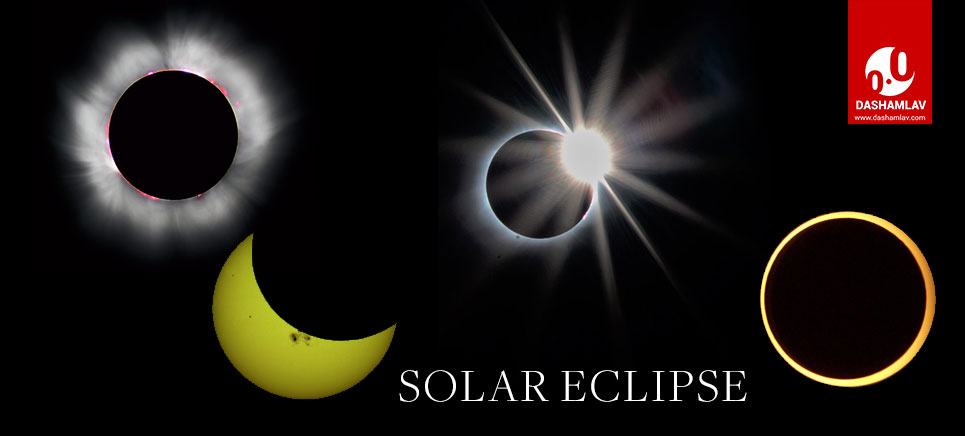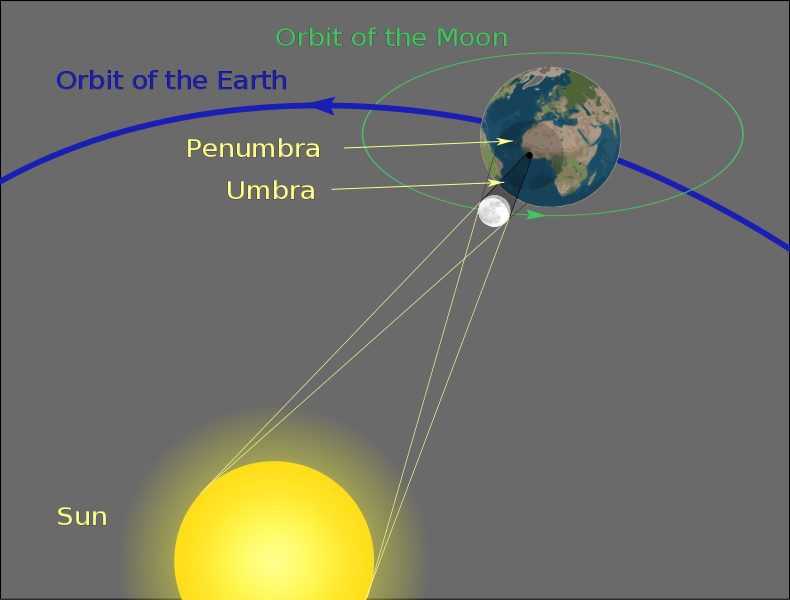Solar Eclipse is a celestial event that occurs when Moon comes in between Earth and the Sun causing earth to get engulfed in Moon’s shadow which partially or totally blocks the sunlight. Although solar eclipse is a fully explicable natural phenomenon, many cultures around the world have been seeing the solar eclipse as a bad omen. During the total solar eclipse, all the sunlight gets blocked and daytime temporarily becomes dark. This probably could explain why people have feared solar eclipses since the time immemorial.
Here are some interesting facts about this simple and yet amazing event.
1. Total Solar Eclipse
A total solar eclipse occurs when Moon hides the complete disc of the Sun. The duration for which the sun remains totally obscured is called the Totality. Only solar prominences and coronal filaments of the Sun may be visible during the totality.
2. Total Solar Eclipse is a Coincidence
Often people wonder how can Moon totally obscured the Sun? Moon is so much smaller than the Sun, then how can such a small body hide a massive object like the Sun? Well, it is a coincidence that the Sun’s distance from Earth is about 400 times the Moon’s distance, and the Sun’s diameter is about 400 times the Moon’s diameter. Because these ratios are same, the Sun and the Moon appear almost the same size from the Earth. This is the reason why we get to see the total solar eclipse.
3. Maximum Duration of Total Solar Eclipse
A total solar eclipse can not last more than 7.5 minutes (7 m 32 s to be precise) at one location on Earth. This is because Earth is rotating on its axis at a constant speed. This rotation allows only a maximum of 7.5 minutes for total eclipse to last. This limit is also influenced by movement of Moon, which is orbiting the Earth.
4. Annular Solar Eclipse
An annular solar eclipse happens when Moon, instead of completely covering the disc of the Sun, leaves the Sun’s edges visible. Thus the Sun appears like a ring, or annulus, surrounding the dark disc of Moon.

5. Partial Solar Eclipse
A partial solar eclipse occurs when Moon does not come fully in front of the Sun. Instead, the moon covers a part of the Sun’s disc from the side. Partial solar eclipses can only be noticed when viewed through a telescope or a reflected image of the Sun. This is because a partial solar eclipse does not cause much difference in day light. Even if 90% of the Sun’s disc is covered in partial solar eclipse, there wouldn’t be any significant difference in day light.
6. Hybrid Solar Eclipse
A hybrid solar eclipse happens when the eclipse appears total from some parts of the Earth; and from some other parts the eclipse appears annular. Hybrid solar eclipse is relatively rare.
7. Frequency of Solar Eclipses
Among total, annular and partial solar eclipses, the total solar eclipse is the rarest. It happens on Earth only once every 18 months. However, at any given place on the Earth, the total solar eclipse happens once in 360 to 410 years, on average. If we consider all types of solar eclipses, on average, 2 to 5 eclipses happen every year.

8. The word Eclipse is from Greek
The English word eclipse its has root in the Greek word ekleipsis which means “fail to appear” or “abandonment” or “downfall”.
9. Identical Solar Eclipses
A practically identical solar eclipse happens after every 6,585.3 days (18 years and 11 days). This eclipse cycle period is called saros. The only difference between such eclipses will be a westward shift of about 120° in longitude (due to the 0.3 days).
10. More Facts on Solar Eclipse
- Total solar eclipses cannot be seen from the North Pole and South Pole.
- The last total solar eclipse that exceeds 7 minutes occurred on 30 June 1973. It lasted for 7 minutes and 4 seconds. Previous to this, the 7 minutes+ total solar eclipse occurred on 01 July 1098 which lasted 7 minutes and 5 seconds. There will not be a longer total solar eclipse until 25 June 2150.
Use the citation below to add this article to your bibliography
"Solar Eclipse: Facts, Types, Definition, Diagram and Dates." Dashamlav.com. Web. 12 June 2025. <https://dashamlav.com/solar-eclipse-facts-types-definition-diagram/>
Dashamlav.com, "Solar Eclipse: Facts, Types, Definition, Diagram and Dates." Accessed 12 June 2025. https://dashamlav.com/solar-eclipse-facts-types-definition-diagram/
"Solar Eclipse: Facts, Types, Definition, Diagram and Dates." (n.d.). Dashamlav.com. Retrieved 12 June 2025 from https://dashamlav.com/solar-eclipse-facts-types-definition-diagram/
